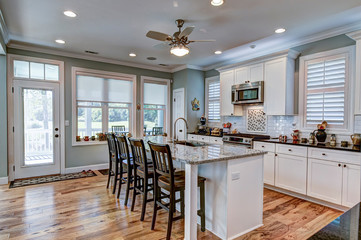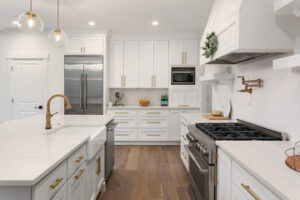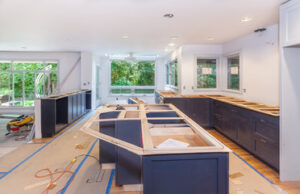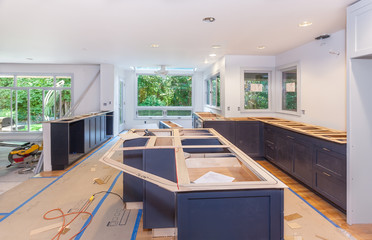Kitchen Remodeling Atlanta can be a great way to upgrade your kitchen and improve its functionality. However, it’s essential to plan carefully and consider your goals.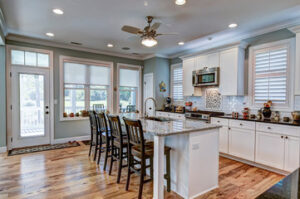
The first step of any kitchen remodeling project is to establish a budget. This can help you avoid spending more than you need to and save money on the items you genuinely want.
The kitchen is one of the most used areas in any home, so it’s important to make sure your appliances are working properly. Upgrading your appliances can help to ensure that they’re working at full capacity and that they’re not using up too much energy. This can save you money on your energy bills and help to reduce your carbon footprint.
Upgrading your appliances can also help to give your kitchen a more modern aesthetic. If you’re using a basic dishwasher and stove, upgrading to something that has a more contemporary look can give your kitchen a nice upgrade. Plus, many of the newer appliances are designed with technology that can help to simplify your life. For example, a high-end refrigerator may have a built-in water dispenser or an automatic sensing system that can detect when you’re approaching the fridge and turn on the lights for you.
If you’re planning on selling your home in the future, upgrading your appliances can also help to add value to your home. Potential buyers will be drawn in by the updated looks and innovative features of your new appliances. So, if you’re looking to add some extra value to your home, consider upgrading your appliances during your next kitchen remodeling project.
When choosing your new appliances, it’s important to consider their dimensions. You don’t want to end up with appliances that won’t fit in your existing cutouts or spaces. In addition, it’s always a good idea to choose appliances that are easy to clean and maintain.
Another thing to keep in mind when shopping for new appliances is that there are many different styles and brands available. So, you’ll be able to find something that fits both your budget and your taste.
If you’re planning on hiring a general contractor for your kitchen remodeling project, they should be able to provide suggestions and even plan sketches as part of their bid. This will help you to clarify your ideas and get a better sense of what the project will entail. You can also ask friends and family members for recommendations or visit showrooms to browse the options.
Adding More Storage Space
The kitchen is one of the most popular areas in a home to remodel, and for good reason. It’s a chance to make the space truly your own with colors, storage and capabilities that fit your lifestyle and preferences. Plus, it’s a great way to add value to your home.
However, it’s also easy to get carried away with ideas that aren’t practical or don’t add any real value. Trying to do too much can end up making your kitchen unusable, or worse, force you to do another remodel sooner than you might have expected. Here are a few things to keep in mind when planning your kitchen remodeling project:
If you’re adding more cabinets, it’s important to consider how much storage space you will actually need. It’s easy to underestimate how much food, cookware, appliances and other items you’ll need to store. Also, be sure to include some room for storing decorative items, such as glassware and special occasion dishes.
It’s important to work with a design-build contractor who can help you maximize your storage space and create a functional layout. For example, if you want to include an island in your kitchen remodel, they can help you size it properly so that it’s not too big or too small for the available space.
Another thing to consider is how well your kitchen will function in the future, especially if you plan to live in your house for a long time. Failing to incorporate accessibility features like wider paths, lowered countertops or adjustable shelving may result in your kitchen becoming impractical as your family grows and ages.
Kitchen remodels can be an excellent investment for your home, but it’s crucial to do the research and plan your project carefully. A professional can help you avoid common kitchen remodeling mistakes that can cost you both time and money in the long run. If you’re ready to start designing your dream kitchen, contact a local kitchen design specialist today! Sea Pointe Design & Remodel is an Orange County kitchen design company that has been helping homeowners remodel their homes for over two decades.
Creating a Contemporary Aesthetic
Creating a contemporary aesthetic in your kitchen doesn’t have to be a difficult task, nor does it need to cost the earth. There are plenty of affordable kitchen design ideas that can help you achieve this look, while also enhancing your home’s value and appeal in the process.
One of the most common characteristics of contemporary kitchen design is clean lines. Slab-style cabinetry, for example, offers a sleek appearance that contributes to the modern feel of a room, while also allowing other elements – like metallic hardware or a patterned backsplash – to stand out and add visual interest. Similarly, flat-panel doors and minimally textured walls can help give a room a more modern feel without sacrificing functionality.
Limiting the color palette is another key element of achieving a contemporary aesthetic. White and neutral colors are popular in contemporary designs, as they instantly brighten a space and create an airy, open feeling. However, if you are looking to make a more dramatic impact, consider incorporating black into your kitchen design. From countertops to cabinets, black finishes can be a striking statement and are sure to catch the eye of anyone who enters your kitchen.
Marble or limestone worktops are a stunning addition to any kitchen, bringing natural textures and hues into the room without overwhelming it with busy patterns and colors. Marble and limestone also bounce light around the room, further enhancing the sense of space and bringing a touch of luxury to your kitchen.
Using colored tiles is a great way to inject personality into a contemporary kitchen while still sticking to a limited color palette. Whether it’s a bold geometric pattern or a mosaic of rich hues, these colorful accents can help add depth and character to a room.
If you’re interested in embracing a more contemporary aesthetic but are unsure where to start, consider upgrading your countertop. Quartz countertops are a popular choice for contemporary kitchens because they offer an elegant and polished look. They also come in a wide variety of colors, so you can find the perfect option to suit your style.
Adding Value to Your Home
A new kitchen can boost your home’s value, allowing you to sell it faster and for more money. However, you should be cautious about over-customizing your remodel. If you overspend, it may limit your potential home-buying audience and make it more difficult to recoup your investment in the future.
The type of kitchen remodeling you choose depends on your goals and budget. For example, you can add value by installing smart appliances or energy-efficient windows. You can also create a more modern aesthetic by changing your cabinetry or backsplash. Alternatively, you can save money by using less expensive materials or refinishing your existing cabinets.
You can also increase your home’s value by making it more accessible. For example, you can install an entry door that opens wide for wheelchair access or install a kitchen island that’s easy to move around in. If you’re unsure about which upgrades will add the most value to your home, consult a real estate expert for advice.
What’s the difference between a renovation and a remodel? A remodel is a dramatic transformation that can transform a cramped galley kitchen into an open-concept space with a large island. A full kitchen remodel can also include expanding the room, removing walls and moving electrical and plumbing fixtures. It requires a bigger budget than a renovation and often requires professional design and construction services.
While upgrading your kitchen with custom features like a walk-in wine cellar or custom cabinets is a great way to increase your home’s resale value, you should avoid over-customizing. Overly personalized features can limit your potential home-buying audience and reduce the number of interested parties. In addition, overly custom features may be difficult to maintain and will require frequent repairs or replacements.
You can also add value to your home by replacing outdated kitchen appliances with high-efficiency models. A new refrigerator or dishwasher can be a cost-effective way to upgrade your kitchen and improve its energy efficiency. Choosing ENERGY STAR-certified appliances can also help you save on your utility bills. If you’re unsure how to finance your remodel, you can always consider a personal loan. This type of loan does not use your home as collateral and can provide a lower interest rate than secured loans.

